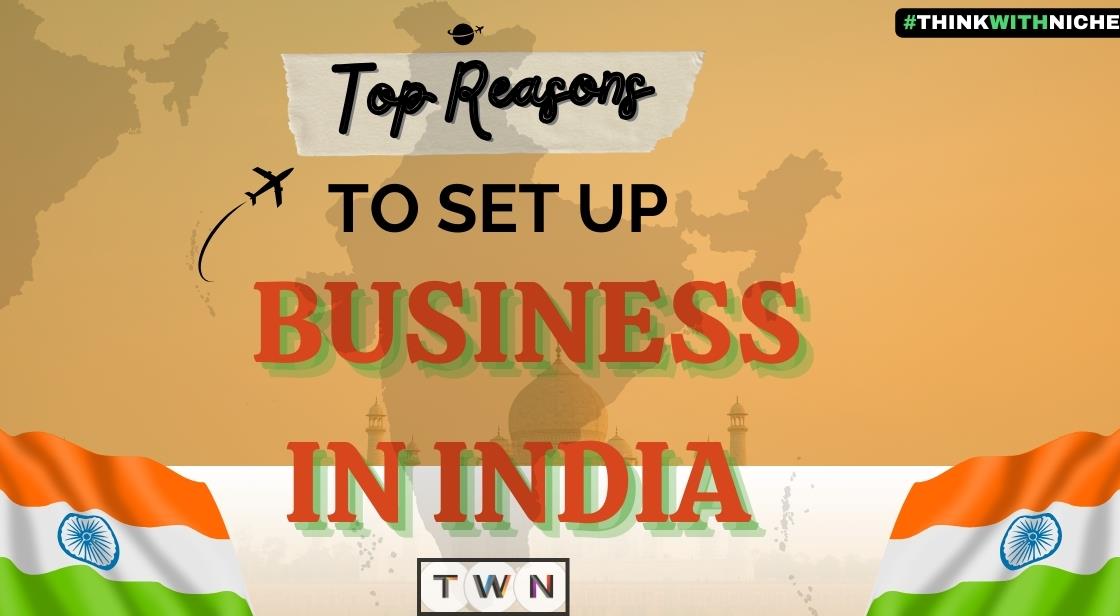Top Reasons to Set Up a Business in India

Blog Post
India is more than just a fast-growing market — it is a strategic launchpad for global businesses aiming to scale with innovation, efficiency, and sustainability.
From its unmatched demographic advantage and cost competitiveness to its rapidly expanding digital and physical infrastructure, India offers a unique blend of opportunities across sectors.
Backed by robust policy support, a transparent financial ecosystem, and a thriving entrepreneurial spirit, the country is well-positioned to drive global business transformation over the next decade.
Whether you're looking to tap into a massive consumer base, leverage skilled talent, or contribute to green growth, India provides the ideal environment to build, innovate, and lead.
Key Benefits of Doing Business in India
India is on the fast track to becoming the world’s third-largest economy by 2030. With transformative growth across technology, renewable energy, and consumer sectors, the country offers unmatched opportunities for businesses looking to expand or establish their global footprint.
With a population of over 1.44 billion — most of whom are digitally skilled and entrepreneurial — India is set to play a pivotal role in the future global economy. Government reforms aimed at enhancing innovation and reducing business bottlenecks further strengthen the case for investment. Here's a detailed look at 10 compelling reasons why India is the go-to destination for business growth.
1. Expansive and Youth-Driven Consumer Market
A Demographic Advantage Fueling Demand
India boasts the world’s largest youth population, with 65% of its citizens under the age of 35. This massive demographic segment is aspirational, tech-savvy, and increasingly inclined toward premium products, digital experiences, and innovative services.
Rising Incomes and Middle-Class Boom
Rapid urbanization and rising disposable incomes are pushing India’s consumer spending to new heights. It's projected that household consumption will reach $4.3 trillion by 2030. This expansion is already transforming demand in industries such as FMCG, e-commerce, real estate, infrastructure, and digital services.
2. Skilled Workforce and Growing Talent Base
The World's Largest Pool of Young Professionals
India's demographic dividend offers a strong competitive edge. Over 62% of the population falls within the working-age bracket (15–59 years), with a majority under 25. By 2030, India will have the highest working-age population ratio among large economies at 68.9%.
Strong STEM Education and Government Skill Initiatives
The country produces around two million STEM (science, technology, engineering, and mathematics) graduates annually — the highest globally. Government programs like Skill India and Pradhan Mantri Kaushal Vikas Yojana continue to develop real-world job skills, making India a talent powerhouse across sectors including IT, healthcare, clean energy, and manufacturing.
3. Business-Friendly Regulatory Reforms
Streamlined Compliance for Ease of Doing Business
India has taken significant steps to simplify regulations, lower red tape, and make doing business easier. The introduction of the Goods and Services Tax (GST) unified the tax regime, improving transparency and reducing compliance costs.
Legal Reforms and Fast-Track Approvals
-
Over 42,000 compliance requirements have been eliminated.
-
More than 3,400 outdated legal provisions have been decriminalized.
-
The Insolvency and Bankruptcy Code (IBC) has improved debt recovery and financial resolution speed.
-
The National Single Window System (NSWS) offers centralized approval mechanisms.
-
Tools like India Investment Grid (IIG) and a universal PAN system simplify investment discovery and regulatory procedures.
These reforms collectively ensure a more predictable and transparent business environment.
4. Rapidly Expanding Digital Infrastructure
Building a Future-Ready Digital Economy
India’s digital economy contributed 11.74% to its GDP in FY 2022–23 and is set to account for nearly 20% by 2030. Key digital enablers include:
-
Aadhaar for biometric identification
-
UPI for seamless real-time payments
-
DigiLocker for secure cloud document storage
Connectivity Reaching the Last Mile
The BharatNet initiative is expanding broadband connectivity to even the most remote regions, enabling businesses to tap into untapped rural markets. With over 900 million internet users expected by 2025, the digital-first approach will continue to open new frontiers for enterprises.
5. Strong Government Support via Flagship Schemes
Incentives Driving Innovation and Industrial Growth
One of the key factors making India an attractive business destination is the proactive role of the government in fostering innovation, entrepreneurship, and industrial expansion. The Indian government has introduced a series of robust flagship schemes aimed at creating a conducive environment for business growth, boosting domestic manufacturing, and attracting global investors.
Production-Linked Incentive (PLI) Schemes:
The PLI schemes, with a total outlay of ₹1.97 lakh crore, cover 14 critical sectors such as electronics, pharmaceuticals, telecom, textiles, auto components, and solar PV modules. These schemes offer direct financial incentives to manufacturers based on their incremental sales and production capacities.
The goal is to increase India’s manufacturing competitiveness, reduce import dependence, and make India a global production hub. These incentives have already led to significant investments from major global and domestic players, strengthening the local supply chain ecosystem.
Make in India Initiative:
Launched in 2014, the Make in India campaign aims to transform India into a global design and manufacturing powerhouse. It focuses on fostering innovation, enhancing skill development, protecting intellectual property, and building best-in-class manufacturing infrastructure.
By targeting key sectors such as automotive, aviation, biotechnology, defense manufacturing, and electronics, the initiative promotes indigenous capabilities while also inviting foreign direct investment (FDI) in core industries. This has helped India steadily climb global manufacturing and ease-of-doing-business rankings.
Startup India Mission:
Startup India is a flagship initiative launched to build a strong startup ecosystem that nurtures innovation and generates large-scale employment opportunities. As of 2025, over 1,70,000 startups have been officially recognized by the Department for Promotion of Industry and Internal Trade (DPIIT).
The program offers benefits like tax exemptions for three consecutive years, easier compliance norms, self-certification under labor and environment laws, access to government tenders, and funding support through the Fund of Funds for Startups (FFS). It has significantly reduced entry barriers and inspired young entrepreneurs to launch innovative ventures across sectors like fintech, edtech, healthtech, agritech, deep tech, and cleantech.
Digital India Initiative:
Digital India is another transformative government program aimed at bridging the digital divide and enabling widespread technology adoption across urban and rural India. The initiative is centered around three key vision areas: digital infrastructure as a core utility, governance and services on demand, and digital empowerment of citizens.
Under this umbrella, initiatives such as Aadhaar, DigiLocker, BharatNet, UMANG app, and Unified Payments Interface (UPI) have revolutionized the way businesses interact with customers, employees, and government systems. Digital India not only boosts transparency and efficiency but also creates a strong foundation for startups and established businesses to thrive in a digital-first economy.
6. Strategic Location and Evolving Supply Chain Networks
A Trade Hub with Global Reach
India’s geographic position offers strategic access to Southeast Asia, the Middle East, and Africa. It is naturally positioned to serve as a global trade and logistics hub.
Infrastructure Backed by Connectivity
-
12 major ports and over 200 minor ports support seaborne trade.
-
150+ operational airports (33 international) ensure seamless air connectivity.
-
Indian Railways — the fourth-largest rail network globally — carries over 4.3 million tonnes of freight daily.
Trade pacts like CEPA and over 50 Free Trade Agreements (FTAs) expand India's access to global markets, enabling exporters to benefit from preferential tariffs and smoother regulatory frameworks.
7. Transparent and Regulated Financial Ecosystem
Safeguarding Investor Interests
India's financial system is supported by well-established regulatory bodies:
These institutions ensure financial stability and transparency. Cumulative FDI inflows crossed $1 trillion since 2000, with ~$16.65 billion recorded in FY 2024–25 (till December). Reforms in banking and fintech continue to make credit access more efficient and inclusive for businesses.
8. Cost-Efficiency and Competitive Advantage
Lower Input Costs Across Sectors
India offers cost-effective operations in terms of labor, infrastructure, and logistics. It’s an ideal destination for labor-intensive industries like apparel, automotive components, and consumer electronics.
Service Sector Edge
India is also a global leader in services like IT, research and development, and healthcare. It is home to:
-
1,700+ Global Capability Centres (GCCs)
-
One of the world’s largest pools of English-speaking professionals
-
Highly skilled and affordable healthcare workforce
These advantages enhance profitability and operational efficiency for global companies.
9. Vibrant Startup Ecosystem and Innovation Landscape
Third-Largest Startup Ecosystem in the World
India’s startup ecosystem is flourishing, with innovation hubs across fintech, AI, agri-tech, edtech, and clean tech. Government-backed programs like the Fund of Funds for Startups (FFS) support early-stage ventures with funding and mentorship.
Rising Unicorns and Global Recognition
India is home to 118 unicorns and ranked 39th in the Global Innovation Index 2024, a testament to its thriving entrepreneurial ecosystem. Innovation is also expanding into Tier-2 and Tier-3 cities, democratizing startup culture across the country.
10. Green Growth and Sustainability Commitment
Leading the Global Energy Transition
India is aggressively transitioning toward a sustainable economy. Its climate goals include:
-
Reducing the emission intensity of GDP by 45% by 2030
-
Reaching 50% of power generation from non-fossil fuel sources
Renewable Energy Milestones
-
As of December 2024, India’s renewable energy capacity stood at 209.44 GW
-
Target: 500 GW of non-fossil energy capacity by 2030
Emerging sectors such as green hydrogen, electric vehicles, and battery storage present lucrative investment opportunities aligned with ESG goals.
Final Thoughts: Why India is the Ideal Business Destination
India combines scale, skill, speed, and sustainability — the four cornerstones of modern business success. With digital innovation, pro-business reforms, and a young, talented population, India offers a fertile ground for building and scaling businesses.
For companies looking to diversify markets, reduce operational costs, and access future-ready talent, India stands out as a top strategic choice. Whether you're a startup founder or a global corporation, the Indian growth story is one you’ll want to be a part of.
You May Like
EDITOR’S CHOICE












